Architect Edward Jeaffreson Jackson
Table of Contents
- See also Shellcove Road Neutral Bay
- See also Mosman Federation Heritage
 |
| Hollowforth, 146 Kurraba Road, Neutral Bay |
"Federation architecture, as this style is broadly known, includes characteristic features such as high-pitched red roofs, tall chimneys, decorative woodwork and leaded windows. Jackson claimed credit for introducing the red terracotta roof tiles that spread across Sydney’s North Shore in the early twentieth century. The tiles were so popular that Jackson himself came to refer to them as “scarlet fever.”
"Jeaffreson Jackson was born in 1862 in London and trained as an architect in England attending the Royal Academy School of Architecture. Articled to William West-Neve he developed an arts and crafts aesthetic. In 1884 he sailed to Australia where he began work with the Colonial Architect's Branch of New South Wales before establishing his own practice between 1885 and 1888. (Dudman, Two Houses by E. Jeaffreson Jackson)
"Recently married, Jackson arrived in Sydney in 1884 keen to take advantage of the opportunities available to young architects in this thriving city. His buildings ranged from houses to banks and commercial buildings to fire stations. He worked for various architects, the Government Architects office and also established his own practice in partnership."
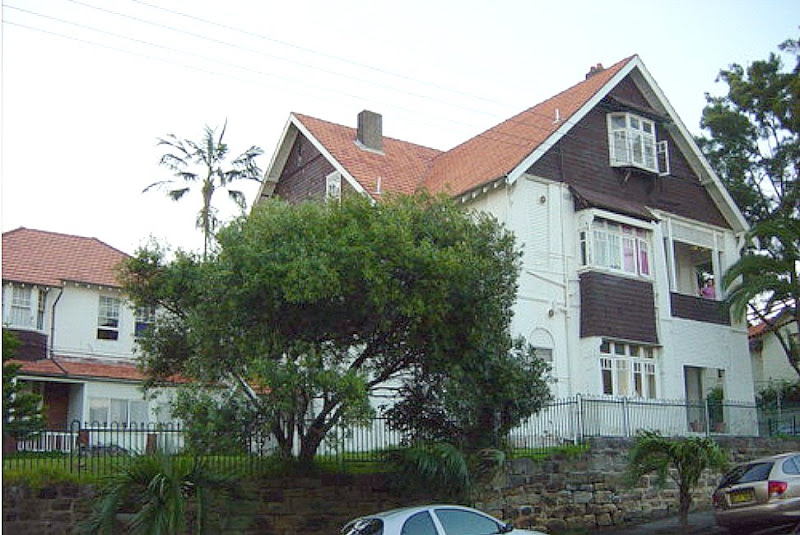 |
| 9-11 Mans Avenue Neutral Bay |
"A resident of North Sydney for many years, many of his domestic designs still survive on the North Shore.[2] "Jackson’s house, Hanney, was built in the 1880s in Alfred Street, Cammeray. It incorporated many Arts and Crafts features including tall rough-cast chimneys, decorative woodwork and high-pitched and varied red roof tiles. The house was demolished to the 1960s to make way for the Warringah Freeway. Other notable Jackson designs that still survive today are the vicarage for St Thomas’s Church in North Sydney, Hollowforth near Shell Cove and Kelrose, which now forms part of North Sydney Council chambers."[3]
|
|
"Jackson is notable for a number of reasons including developing English Arts and Crafts style into an Australian architectural form known broadly as Federation style. He was one of the first to introduce the bungalow style to Sydney, (a bungalow being a single or two storey house composed under a sprawling roof). It is also thought that he introduced the terracotta, Marseille patterned tile to Australia. Later however he seemed to regret this, referring to these roof tiles as looking like ‘scarlet fever’ and ‘akin to a rabbit plague’ noting that he now preferred shingles with their silver grey appearance which toned with the landscape.
"Unfortunately when Jackson returned to England in 1908 possibly to find husbands for his daughters, he struggled to find work. What a contrast to the success he enjoyed while in Sydney to which he never returned.[5]
 |
| House 17 Calypso Avenue Mosman |
1. 'Hindfell', 11A Lucinda Avenue, Wahroonga, 1901-02
House for Henry Gullett; Builder: Brown and Tapson; Cost: £1,685
The design of the house, with its shingling, arches and prominent bracketed oriel window under a large jettying gable was very influential. An almost identical design was used some years later by builder William Richards for “Mounteray”, in Burwood Road, Burwood, as part of George Hoskins’ Appian Way subdivision.
“It is, in the first place, an essentially comfortable Australian home; it is picturesque without any obvious straining after effect; it has absolutely no unnecessary ornamental detail; and it groups well. No money has been wasted in attempting to achieve mere prettiness, and yet the house cannot fail to be interesting to any one who cares in the slightest degree for domestic architecture.”[7]
Heritage listed buildings by E. Jeaffreson Jackson
A. Heritage Listed under the NSW Heritage Act:
2. 'The Budds', 28 Mistral Avenue Mosman Mosman
"28 Mistral Avenue has historic and aesthetic significance as a rare Sydney example of a residence designed by the noted architect E. Jeaffreson Jackson around the turn of the century (1900) in the shingle (Federation Arts & Crafts) style displaying a North American influence. The house is essentially intact and retains most of its original external detailing and materials including its timber shingles, casement windows and terracotta tiles. The house is complemented by its tennis court and street tree planting of brush box (Lophostemon confertus) trees. [8]Modifications and dates:
- "Lady Budd said that the house had been altered before her family lived there and that she and her husband had made several extensive renovations. "We bought the house from people named Jesson, who had let it for many years," Lady Budd said. "The Jessons put in the tennis court." The Budds had the house re-roofed when the tiles started to deteriorate "about 20 years ago" and had installed fireplaces in 2 of the upstairs bedrooms.
- A china cabinet downstairs hid another fireplace. A long living room downstairs, originally two rooms separated by sliding doors, was altered and dark wooden panelling, typical of pre-war interior design, was removed. The Budds also made extensive alterations to the kitchen, converting two pantries into a scullery and laundry.(Mosman & Lower North Shore Daily, 1981).
- 1988+: Addition of a garage & parent`s bedroom
- Swimming pool installed, c2000.
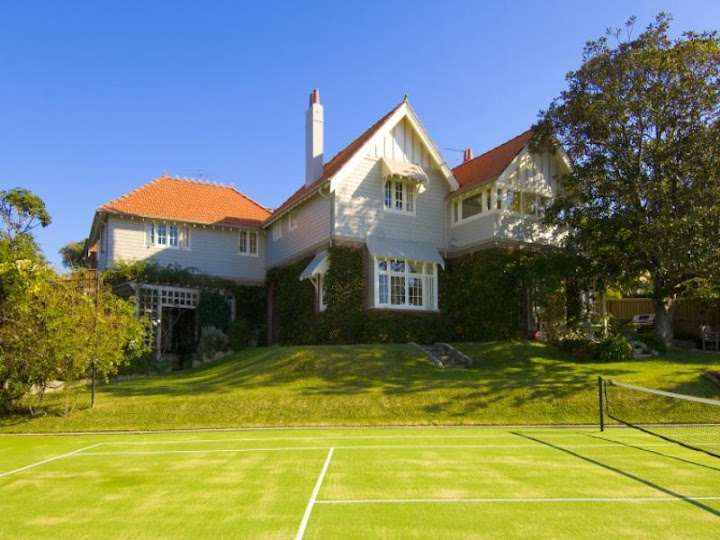
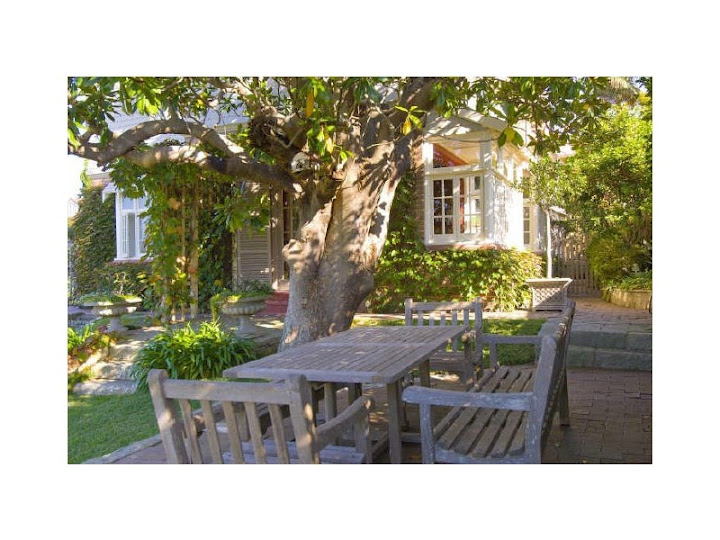 |  |
"Jeaffreson Jackson was an influential and innovative architect in the area of residential designs with examples of his work appearing in Arts and Architecture and other leading magazines of the day."
"No. 28 Mistral Avenue is sited opposite that of another house designed by the same architect producing an important group relationship. Both houses are essentially intact and located on corner sites, this combined with their two storey height, similar style, distinctive designs and landscaped setting of extensive lawns produces an interesting townscape element"[7]
The property has historic associations as the home for 36 years of a former president of the Legislative Council of NSW and managing editor of the Land newspaper, Sir Harry Budd, and his family until his death (1978)(Mosman & Lower North Shore Daily, 1981, modified by Read, S., 25/5/2007). The grass lawn tennis court forms an essential part of the curtilage of the building and has been designed to relate to it as the garden front. This site is considered to form the minimum comfortable curtilage for the house (Branch Manager's report no.376/81, 6/10/1981).
No. 28 Mistral Avenue is sited opposite that of another house designed by the same architect producing an important group relationship. Both houses are essentially intact and located on corner sites, this combined with their two storey height, similar style, distinctive designs and landscaped setting of extensive lawns produces an interesting townscape element (Branch Manager's report no.376/81, 6/10/1981). A large residence set in extensive grounds that, by virtue of the composition of its three major unified wings, avoids overly dominating its setting
B. Heritage Listed by Local Government and State Agencies:
3. The Hastings, 2 Hayes Street Neutral Bay North Sydney
"A large, dramatically designed Federation Arts and Crafts style house on an important harbourside site. Design is attributed to noted architect E Jeaffreson Jackson. Site includes a stone wall which may be associated with "Thrupps Cottage" or "Craignathan" both important early houses. It forms a part of the collection of large fine houses in the vicinity.
|
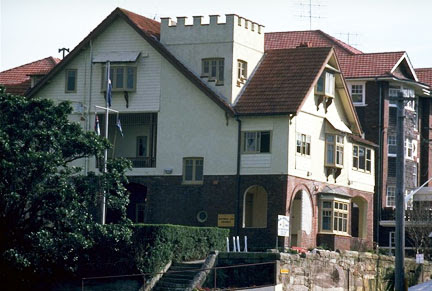 2 Hastings Street Neutral Bay | 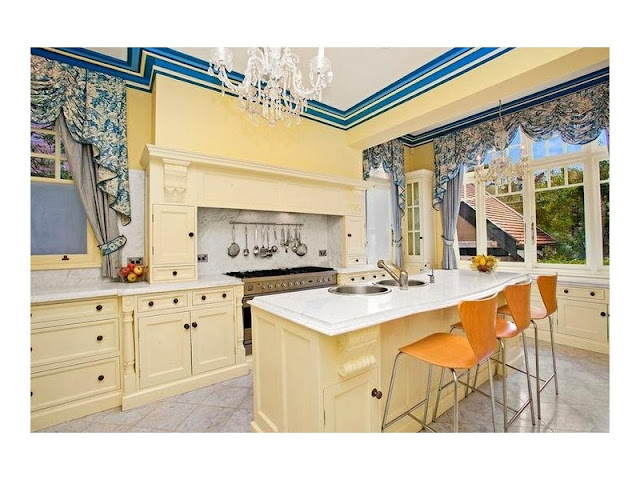 2 Hastings Street Neutral Bay | 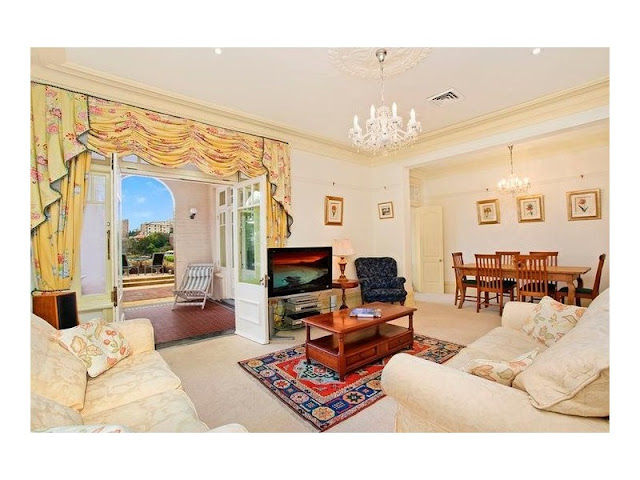 2 Hastings Street Neutral Bay |
4. Hollowforth, 146 Kurraba Road Neutral Bay
A dramatic and innovative architectural statement in the shingle style by one of the leading architects of the Federation era, E. Jeaffreson Jackson. Hollowforth joins with a number of Horbury Hunt's commissions to represent the finest examples of this style within the State.
|
|
|
The roof structure was partially damaged by a fire in 1994 but subsequently reconstructed to original detail. Of particular note are the undulating stone garden walls that surround the symmetric picturesque design. Note the shingled wall surfaces, numerous stopped hips, dormer windows and massive brick chimneys on the roofline and exposed timber beams of the projecting first floor.[11]
5. House 17 Calypso Avenue Mosman
"This is an unusual example of the Arts-and-Crafts style of domestic architecture, a style which is a fairly common and important part of Mosman's historical development. This house was given a most distinguished treatment by an architect eminent in the Federation period in NSW.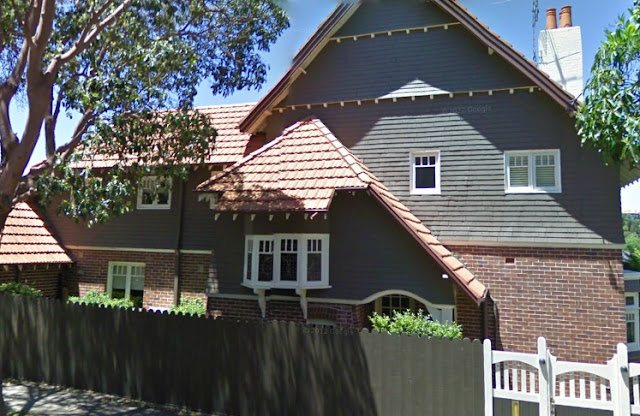
"Federation Arts and Crafts. A two-storey house, built close to the Calypso Avenue boundary but well back from the much narrower thoroughfare of Magic Grove. It has brick, cement-rendered and timber-shingled walls and is crowned by a remarkable composition of fairly steeply-pitched gabled and hipped roof elements, including a catslide roof, covered in terracotta tiles.
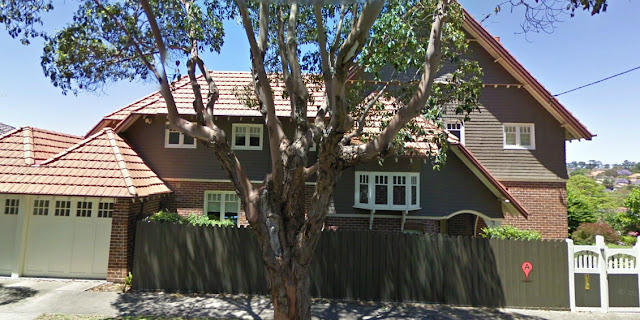 |
| Streetview, 17 Calypso Avenue Mosman |
The main gable faces Calypso Avenue, along with a most unusual facetted and bracketted oriel, and a small entrance porch. Some of the face brickwork is painted and the attic storey is sheeted with shingles. Much of the decoration exhibits Art Nouveau motifs. The house is in fair to good condition."[12]
6. Isla, 89 Wycombe Road Neutral Bay
A large and elaborate house of Federation Arts and Crafts style, design by prominent architects Jeffreson Jackson and James Peddle. Associated with St Augustines Church as the Rectory between 1939 and 1990. One of a collection of fine houses in the vicinity which taken together characterise the area.
A substantial two storey brick house with multi-gabled terracotta tile roof. Features include circular accent windows, semi-circular windows, elaborate timber balustrades and brackets to verandahs, bay windows, shingled gable ends and a roughcast rendered upper storey. This building is designed in the Federation Arts and Craft style.
House built in 1903, for Cargill family, later acquired by the Phillips family. Purchased by the Church as a Rectory in 1939. Coach house and entertainment centre was on north end of house was first a sunday school, then ,comfort centre during WW2, then was adopted as a curate's lodge. Sold to private owners circa 1990.[13]
7. 9-11 Manns Avenue Neutral Bay
An excellent and characteristic example of a large, private house of the Federation period, neatly executed in a conservative Arts and Crafts style. It occupies an important corner site for streetscape vistas. It is a part of a collection of similar houses in the vicinity which together characterised the area.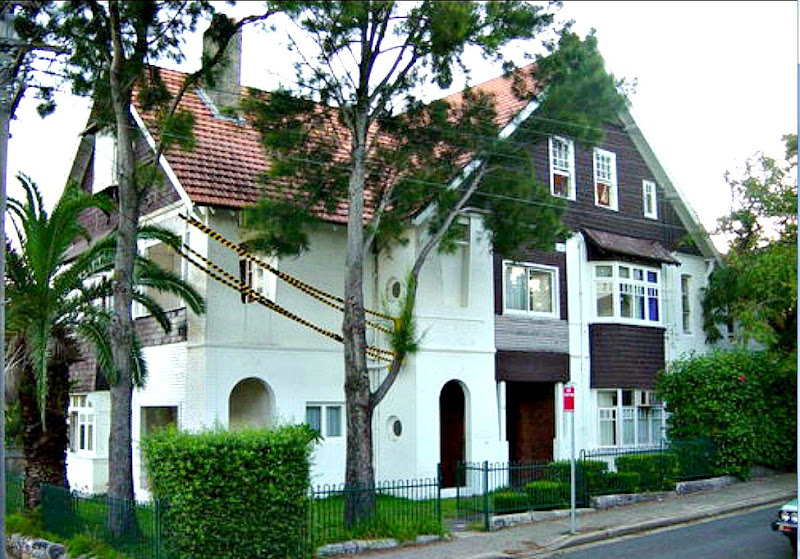
A two storey brick house with an attic storey and terracotta tiled gabled roof. Features include timber shingled gable ends, bay widnows, timber prieze veradah detailing and shingled spandrels to verandah and windows. It is connected to a smaller house of similar detailings on the south side, also of two storeys but with a hipped gable roof and a rendered upper storey. This building is designed in the Federation Arts and Crafts style.[14]
8. Kelrose, now North Sydney Council Chambers 200 Miller Street North Sydney
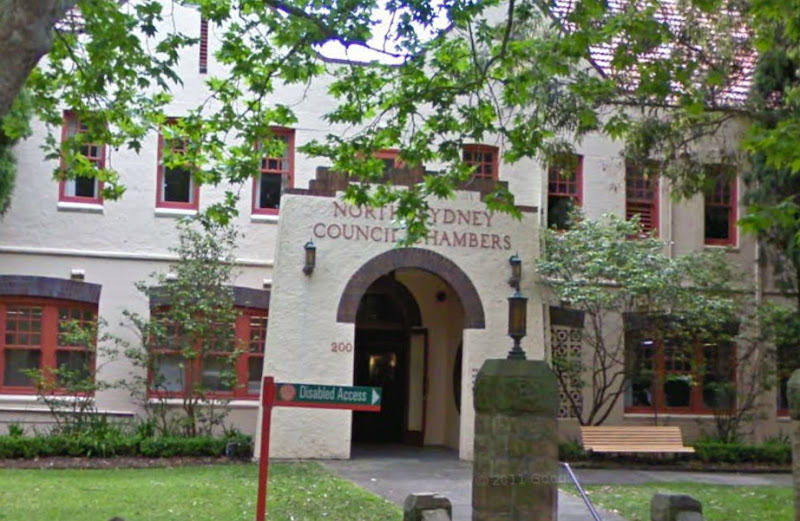
Two storey brick building with hipped and gabled terracotta tiled roof. Upper floor roughcast rendered. Nine pane upper sash double-hung windows. Parapets to gable ends with semi-circular motif above narrow tall ventilator openings. Ground floor has three brick segmental arches over window openings. Entrance porch rough-cast rendered with face brick rectangular parapet and semi-circular arch. Side walls of porch have circular windows articulated in face brick.This building is designed in the Federation Arts and Crafts style.
The site was the 1870 home of James Husband and family. A new house, designed by E. Jeaffreson Jackson, was owned by Dr. Capper and his mother. From this a hand-carved mantelpiece remains in the front building. It was used at times as a home and hospital. Remodelled, this was opened in 1926 by the Rt. Ho. W.M. Hughes as the Council Chambers, enlarged again in 1938. The northern end was burnt out in 1976, restored and re-opened in 1978. The Wyllie Wing, in McLaren Street, designed by Harry Seidler, was completed in 1977 [15]
9. St Augustine's Rectory and Curates Lodge
later, 'Isla', 89 Wycombe Road Neutral Bay (see above)
"A large imposing Federation Arts and Crafts style residence designed by a notable architect which together with the billard room, presents a particularly well designed roofscape carried out with great vigour. Its architectural quality is of a high order and is neatly resolved in relationship to its site. Part of a collection of fine houses which characterise Neutral Bay.
"A two storey face-brick and shingle Federation residence with upper rough-cast stucco walls and multi-gabled asymmetrically massed roof. The main staircase is panelled and defined by the arch-headed window, which as with the front door and window is glazed in leadlight. The verandahs originally contained timber slatted balustrade and fretwork brackets while the rear wing as built, differed from the original plan in being two storeys. A foundation stone dated 1903 was laid by Mrs Cargill, with the ceremonial trowel now being held by the Church. The billard room is a skilful design (reputedly to date from 1914) executed in matching brickwork to the main house. The garden elevation is dominated by a shingled bay window and entry stair while the roof is enhanced by terracotta shingles and two elongated chimney pots.This building is designed in the Federation Arts and Crafts style.
10. St. Thomas Church Rectory 36 McLaren Street North Sydney
"Excellent example of early Arts and crafts style house and example of work of prominent local architect. Associated with adjacent important church and with complementary design features. Part of a group of important ecclesiastic buildings.Two storey brick house with steeply pitched terracotta tiled gable-roof. Features include timber shingles to the gable ends and rain hood over faceted bay window, bracketed boxed eaves, eyelid dormer window, a pointed arched entry to corner verandah and elaborate timber work to the verandah.This building is designed in the Federation Arts and Crafts style.
 | 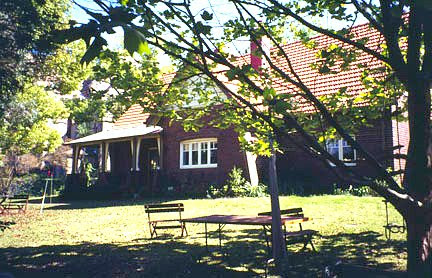 |
 |
| The Voysey House, Chorleywood |
11. Tregoyd, House and Garden 161 Raglan Street Mosman
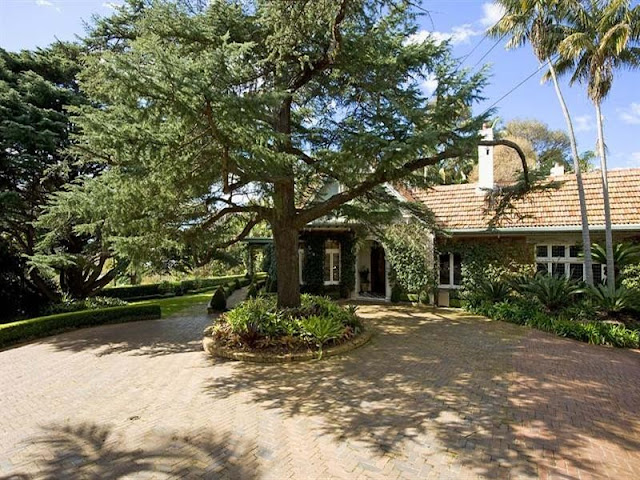
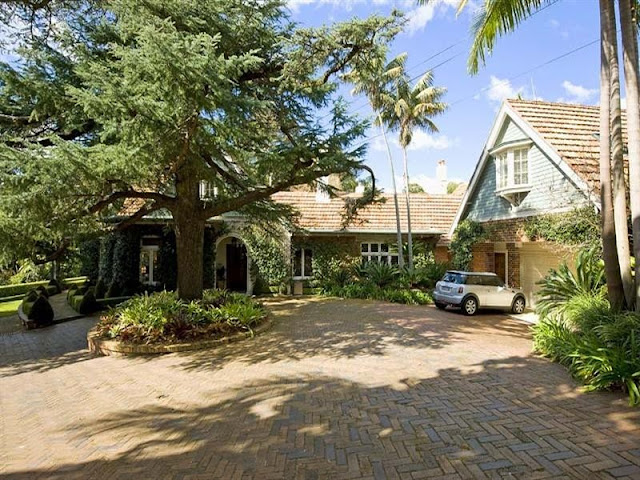
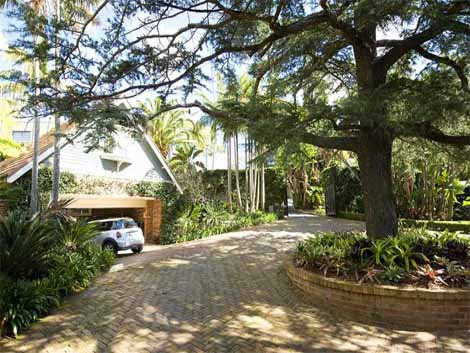 |  |
12. Whispering Pines and Grounds 178-186 Falls Road Wentworth Falls Blue Mountains
"Whispering Pines is a good example of a substantial Federation Arts and Crafts style retreat. The design is of interest with the broad roof gable being more characteristic of central Europe than the typically complex roofs of the Australian federation period. The perimeter of pine trees are important in providing a setting for the house. The two Arbutus trees at the entry contribute to the sense of arrival at the site. | 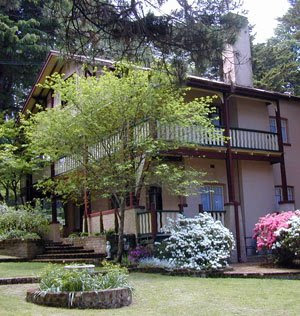 |
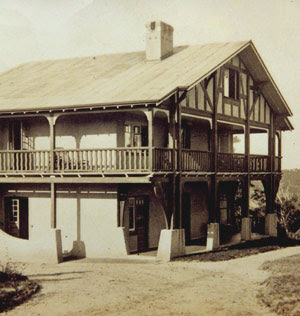 |  |

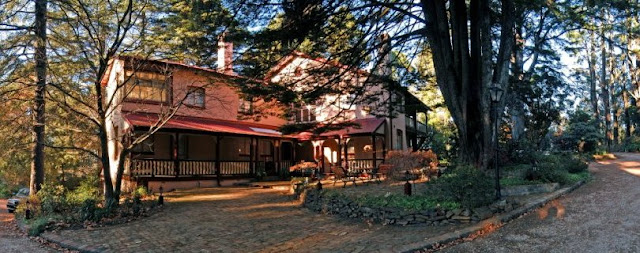
Pines trees around the boundary probably relate to the Childe occupation of the house as does the aged Arbutus at the southwest entry. [18]
- ^ http://architectureau.com/calendar/talk/the-legacy-of-sydney-edwardian-architect-edward-jeaffreson-jackson/
- ^ http://architectureinsights.com.au/events/north-sydney-olympic-pool-75-years-as-a-local-landmark-and-a-national-treasure/
- ^ http://architectureau.com/calendar/talk/the-legacy-of-sydney-edwardian-architect-edward-jeaffreson-jackson/
- ^ Speakers: Ian Stapleton, Sydney heritage architect and Michael Brothers, great grandson of Edward Jeaffreson Jackson.
The Legacy of architect Edward Jeaffreson Jackson
A talk at the Stanton Library, ‘To live in an Air of Restfulness’ The legacy of Edwardian Architect, Edward Jeaffreson Jackson coincided with the renaming of a North Sydney Park, Edward Jeaffreson Jackson Reserve.
Oct. 27, 2011, 1 p.m. - 2 p.m. at Level 1, Stanton Library, 234 Miller Street North Sydney - ^
http://www.sydneyarchitecturefestival.org/event-reviews-2011/the-legacy-of-architect-edward-jeaffreson-jackson.html - ^
http://www.environment.nsw.gov.au/heritageapp/ViewHeritageItemDetails.aspx?ID=5045051 - ^
http://www.sl.nsw.gov.au/discover_collections/people_places/north/architects/docs/north_shore_houses.pdf - ^
http://www.environment.nsw.gov.au/heritageapp/ViewHeritageItemDetails.aspx?ID=5045051 - ^
http://www.environment.nsw.gov.au/heritageapp/ViewHeritageItemDetails.aspx?ID=2181379 - ^
http://www.environment.nsw.gov.au/heritageapp/ViewHeritageItemDetails.aspx?ID=2181244 - ^
http://www.northsydney.nsw.gov.au/resources/documents/35_KurrabaPoint.pdf - ^
http://www.environment.nsw.gov.au/heritageapp/ViewHeritageItemDetails.aspx?ID=2060102 - ^
http://www.environment.nsw.gov.au/heritageapp/ViewHeritageItemDetails.aspx?ID=2181368 - ^
http://www.environment.nsw.gov.au/heritageapp/ViewHeritageItemDetails.aspx?ID=2181294 - ^
http://www.environment.nsw.gov.au/heritageapp/ViewHeritageItemDetails.aspx?ID=2180851 - ^
http://www.environment.nsw.gov.au/heritageapp/ViewHeritageItemDetails.aspx?ID=2180807 - ^
http://www.environment.nsw.gov.au/heritageapp/ViewHeritageItemDetails.aspx?ID=2060409 - ^
http://www.environment.nsw.gov.au/heritageapp/ViewHeritageItemDetails.aspx?ID=1170825

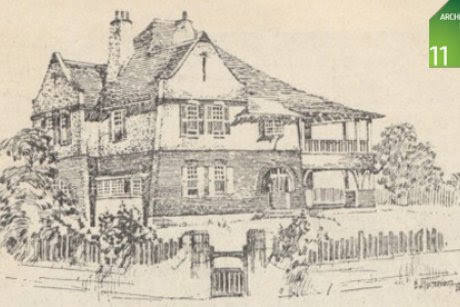


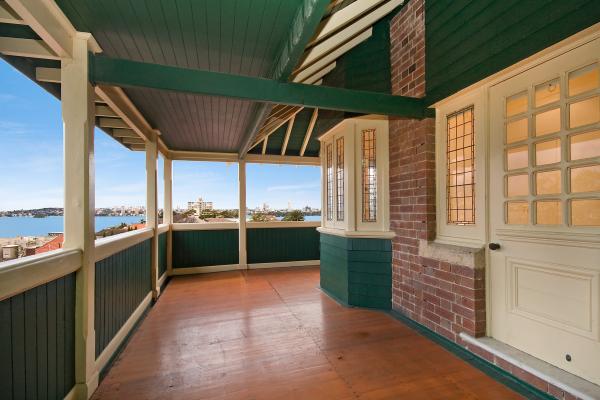
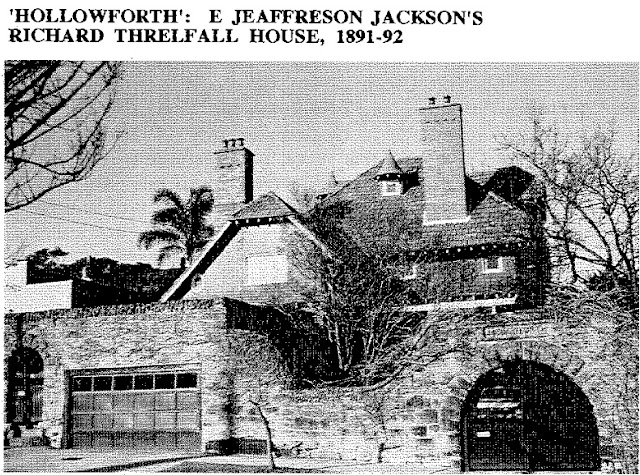
No comments:
Post a Comment